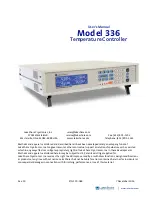
AvL Proprietary and Confidential
Content is Subject to Change without Notice
Page
10
of
195
Chapter 1 - Introduction
1.1
Controller System Overview
The AAQ controller is a unique highly flexible, cost effective, purpose built embedded antenna
controller. The primary application for this controller is for transportable satellite antennas exposed
to harsh environments with demanding performance requirements. The small form factor
packaging of the controller enables its use in a wide range of antenna types – large and small. By
embedding the controller into the antenna pedestal, system cabling and connections are greatly
simplified.
The controller is an IP based network compatible controller that has a single core base code that can
be applied over multiple hardware platforms. Using parametric software that is configurable by
user defined operational profiles, the controller can adapt to virtually any antenna size, positioner or
sensor suite due to its modular approach in software and hardware. Consequently, many different
combinations of sensors, modems, beacon receivers, motors, third party applications and other
devices can be readily integrated and used with the basic system.
1.2 Standard Hardware Components
The hardware architecture employs multiple micro-processors to distribute processing tasks
efficiently and to share processing burdens optimally. The standard hardware consists of two
embedded components, the ACU (Antenna Control Unit) and the NAV RIOM (Navigation Remote
Input Output Module).
The ACU contains a total of five (5) microprocessors – each dedicated to specific tasks. The main
processor is an ARM9. With its extensive memory suite, it is capable of performing all
administrative functions, networking, high level motion control commands, coordinate
transformations, tilt compensation and communication with external devices via Ethernet or serial
connections. A 44-pin dsPIC33 microprocessor is used to communicate with the on board pitch and
roll sensor and to provide additional analog and digital Input / Output capability. Three 28-pin
dsPIC33 microprocessors provide encoder quadrature, servo motion control and PWM (Pulse Width
Modulation) output to each of three standard motors.
The ACU includes an internal 4-port Ethernet switch, an RSL (Receive Signal Level) power meter, bias
tee to supply LNB (Low Noise Block-Downconverter) voltage, tone generator and three motor servo
drives. The ACU is composed of a single PCB (Printed Circuit Board) enclosed in an aluminum
housing with four (4) external connectors.











































